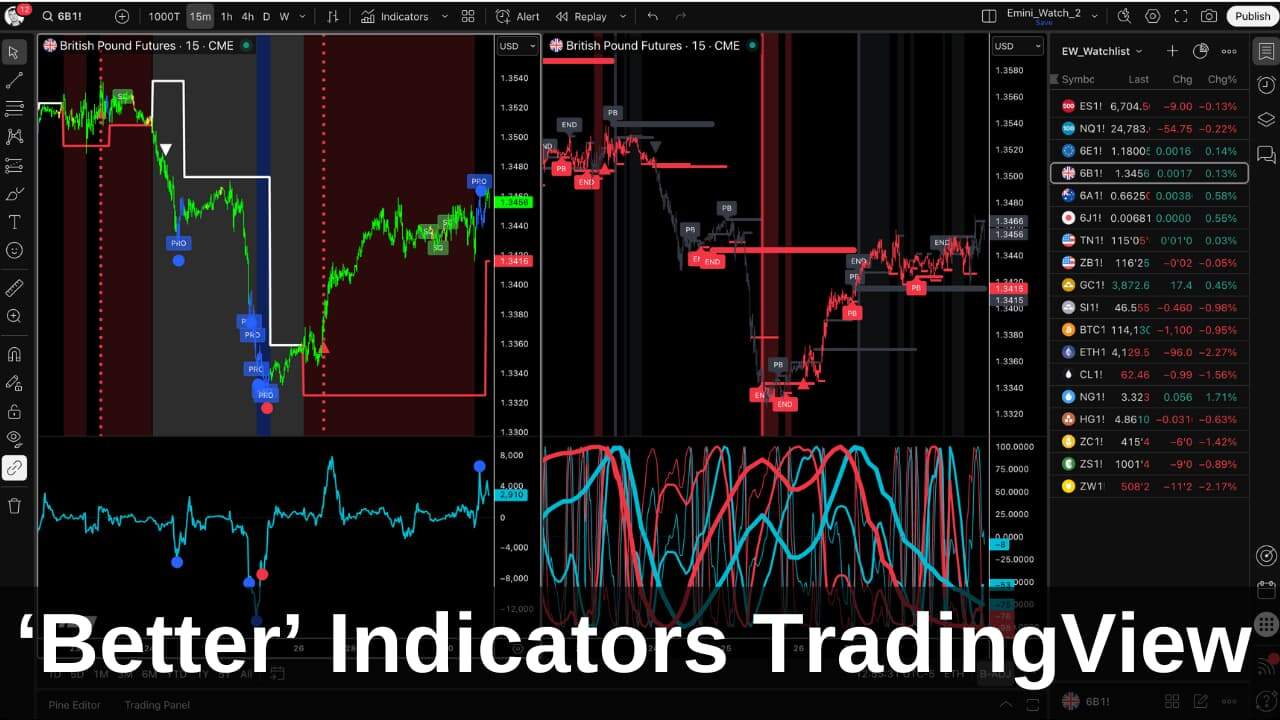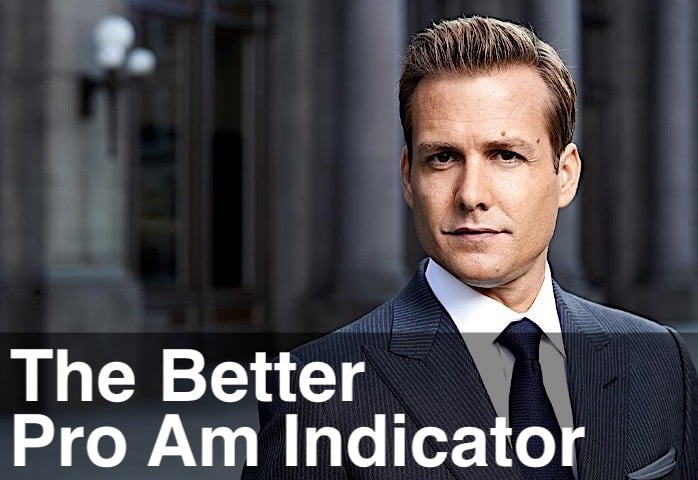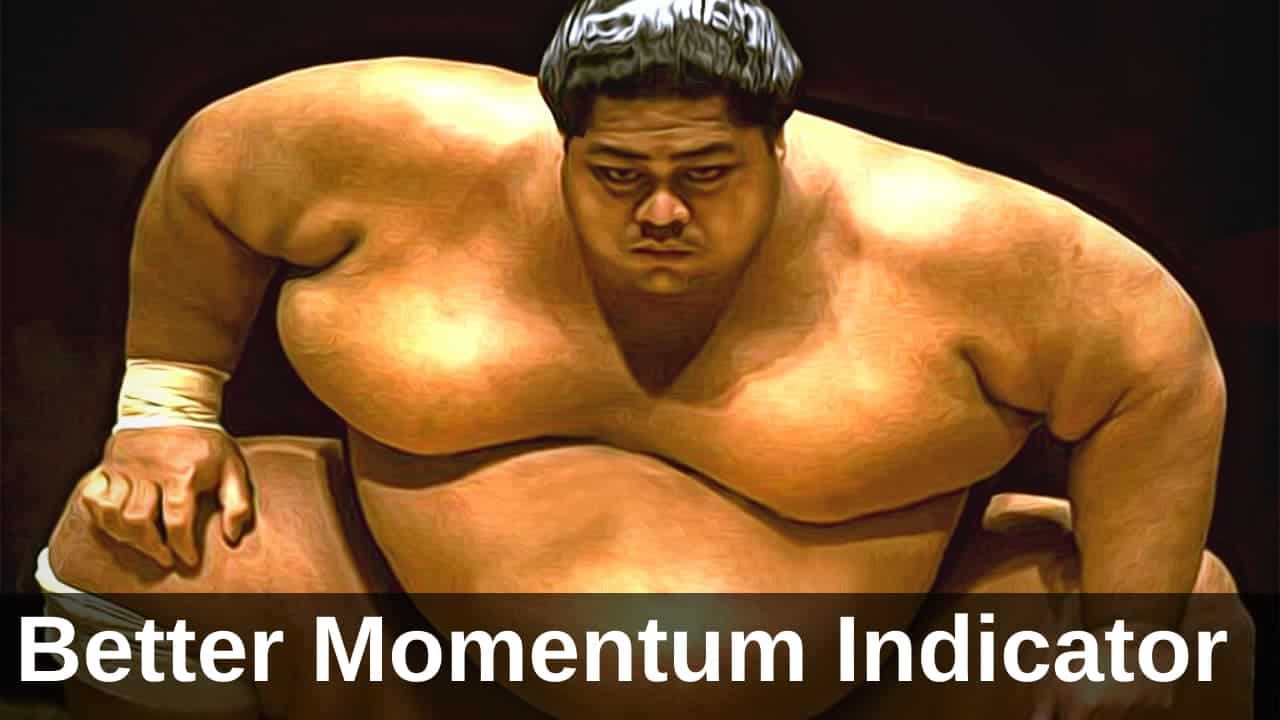The Better Sine Wave indicator is my adaptation of John Ehlers’ Hilbert Sine Wave – a cycle-based oscillator that uses digital signal processing to measure cyclical energy in market prices.
Ehlers’ original version, published in Rocket Science for Traders, does something most indicators can’t: it distinguishes between cyclical and trending price activity. When the market is in a cycle, the indicator plots a normal sine wave with crossovers at turning points. When the market is trending, the lines go “out of sync” and stop crossing – telling you not to fade the move.
I first came across the Hilbert Sine Wave 15 years ago and was hooked. It describes market structure more elegantly than moving averages or trend lines ever could. Since then, I’ve built on the raw cycle measurement and added practical trading signals – that’s why I call my version “better.”
This guide explains how the Hilbert Sine Wave works, what makes it unique, and what Better Sine Wave adds: smart support/resistance levels, pullback signals, end-of-trend detection, and multi-timeframe structure.
Table of Contents
Use the links above to jump to the Hilbert Sine Wave Indicator topics that interest you.
How the Hilbert Sine Wave Works (Ehlers’ Original)
The indicator’s origin story spans mathematics and engineering. David Hilbert (1862-1943) was a German mathematician who developed the Hilbert Transform – a method for extracting phase information from signals. John Ehlers, a digital signal processing engineer, applied this transform to market data and published his findings in Rocket Science for Traders.
The core idea: market prices contain cyclical patterns buried in noise. The Hilbert Transform extracts the dominant cycle from the price data, producing two lines: a Sine Wave and a Lead Wave (sometimes called the “lead line” because it leads the sine wave by 45 degrees).
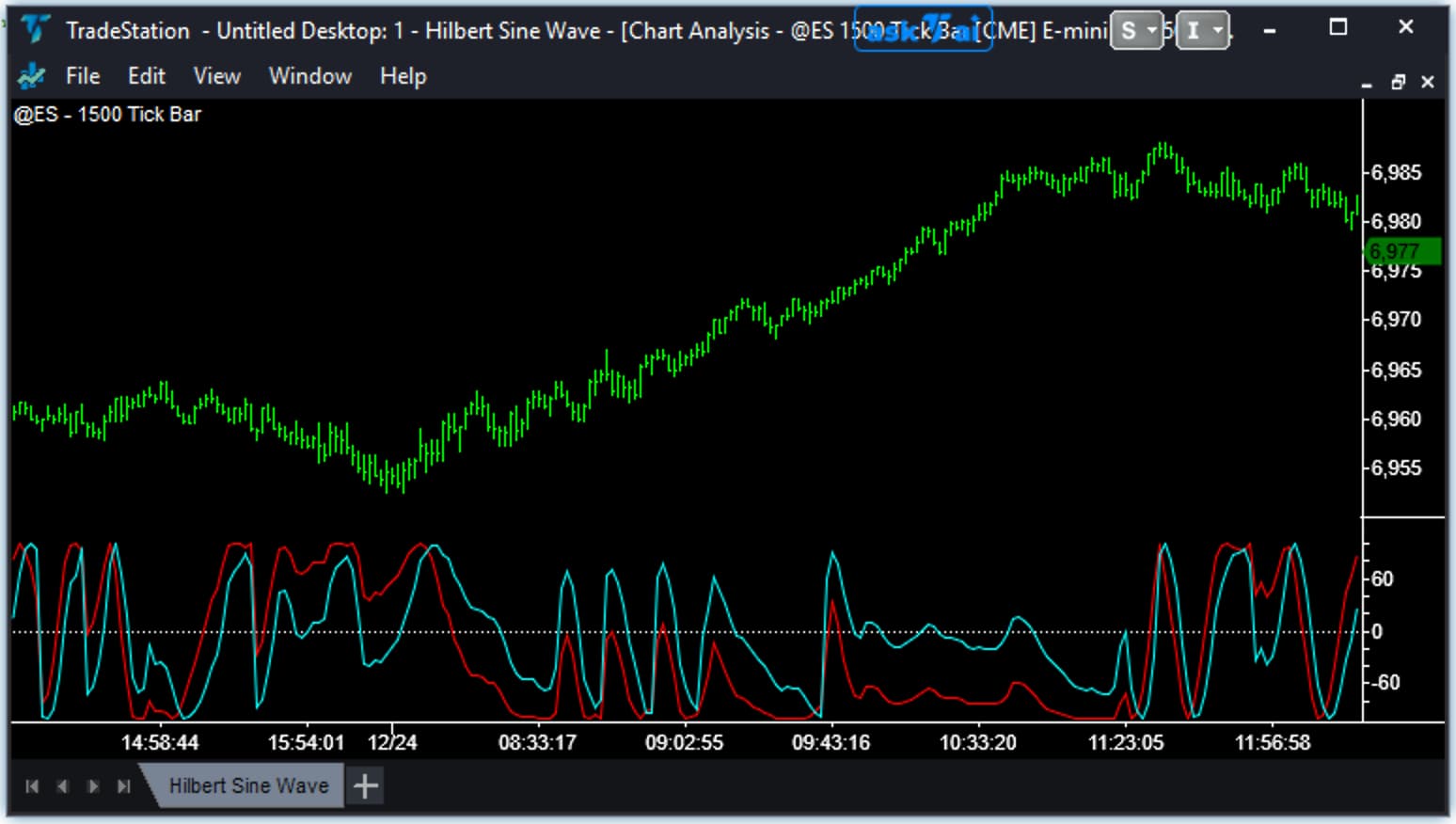
What the Two Lines Represent
The indicator plots as a pair of oscillating lines in a separate pane below the price:
- Sine Wave (blue line): Represents the current position within the dominant market cycle
- Lead Wave (red line): A “look-ahead” line that anticipates where the sine wave is heading
When these lines cross at extreme levels (+100 or -100), it signals a potential cyclical turning point. A cross at +100 suggests overbought conditions; a cross at -100 suggests oversold.
When It’s Useful
In range-bound, cycling markets, the Hilbert Sine Wave works well. Price bounces between support and resistance, the sine wave oscillates predictably, and crossovers at extremes identify turning points with reasonable accuracy.
This is the indicator’s strength: it tells you where you are within a cycle. Are we near a cyclical top? A cyclical bottom? The middle of a swing?
What the Original Doesn’t Give You
The Hilbert Sine Wave tells you the market’s mode – cycling or trending. That’s valuable. But it stops there.
When the indicator shows a market in a cycle, you know the price is range-bound. But where are the support and resistance levels? The original doesn’t plot them. When the lines go “out of sync” and signal a trend, you know not to fade it. But when does that trend end? The original doesn’t tell you.
That’s what Better Sine Wave adds:
- Smart S/R levels – plotted directly on price during cycling phases
- Trend coloring – trend calculations based on breaks of S/R levels
- Pullback and End of Trend signals – so you know when the move is exhausted
- Multi-timeframe structure – see all three market frequencies at once
The original tells you the market’s mode. Better Sine Wave tells you cyclical turning points, breaks into trend and when the trend is about to end.
The Three Timeframes (Market Structure)
Markets “resonate” in three different frequencies simultaneously. This is why fixed-length indicators often fail – they’re tuned to one frequency while the market is operating on another.

The Three Frequencies
- Lowest Timeframe (thin lines): The noise and immediate price action—small swings within larger moves
- Intermediate Timeframe (medium lines): The swing trend—the move most day traders are trying to capture
- Highest Timeframe (thick/bold lines): The major trend—the dominant directional bias
These timeframes typically operate on a factor of 3. If your base chart is 500 ticks, the intermediate timeframe represents roughly 1,500 ticks worth of structure, and the highest timeframe represents roughly 4,500 ticks.
The Critical Insight: Trend = Cycle in a Higher Timeframe
Here’s the concept that changes everything:
A trend in a lower timeframe is a cycle in a higher timeframe.
That explosive move you’re riding on your 500-tick chart? Zoom out to the 4,500-tick chart and it’s just one leg of a larger cycle—from support to resistance.
This means:
- When you see End of Trend signals “ripple” from the lowest timeframe up through the intermediate and into the highest timeframe, the entire move is mathematically exhausted
- When support/resistance from all three timeframes cluster at the same price level, something significant is about to happen
Key Signals: Reading the Chart
The Better Sine Wave produces several distinct signals. Learning to read them quickly is essential.
A. Support & Resistance Levels
Unlike the original Hilbert Sine Wave, which only shows oscillator crossovers, the Better Sine Wave plots “smart” support and resistance levels directly on price.
These aren’t simple pivot points. They’re generated by the cyclical algorithm and represent levels where cyclical energy is likely to reverse—or break through into a trend.
- Red lines below price: Support levels
- White lines above price: Resistance levels
- Line thickness: Indicates timeframe—thin lines for lowest timeframe, medium for intermediate, thick for highest
B. Trend Definition (Bar Colors)
The indicator colors price bars based on market structure—not just simple moving average crossovers:
- Red bars: Strength/Uptrend—price is breaking above cyclical resistance
- White bars: Weakness/Downtrend—price is breaking below cyclical support
The key insight: trend is defined by breaks of support/resistance. As long as bars remain red (even during a dip), the uptrend structure is technically intact. The indicator keeps you in trades longer than your emotions want to.
C. Background Shading (OBOS)
Background colors show overbought/oversold conditions across timeframes:
- Dark red background: Oversold—market in a cyclical low zone
- Gray background: Overbought—market in a cyclical high zone
- Black background: Transition zone—neither extreme
D. Big Things Happen at Triples (BTHAT)
This is one of the most powerful signals.
The Setup: When support or resistance levels from ALL THREE timeframes (Low, Intermediate, High) cluster closely together at the same price level.
The Implication: This represents a massive concentration of cyclical energy. Price cannot ignore this level.
The Outcome: Expect either a Big Bounce (the level holds and price reverses strongly) or a Big Break (the level fails and price trends explosively in the breakout direction).
BTHAT signals require confirmation—you need to see whether price bounces or breaks. But once you have that confirmation, the resulting move is typically significant.
E. End of Trend (EoT) Signals
End of Trend signals appear when trending energy exhausts. They “ripple through the timeframes”:
- First, you get an EoT on the lowest timeframe
- Then an EoT on the intermediate timeframe
- Finally, an EoT on the highest timeframe
When you see EoT on the highest timeframe, the trend is mathematically exhausted. This doesn’t mean price immediately reverses—it means the trending energy has dissipated and the market is transitioning back to cycling/congestion mode.
F. Pullback (PB) Signals
Pullback signals mark retracements within a trend:
- In an uptrend, PB marks a pullback to support—potential entry point
- In a downtrend, PB marks a pullback to resistance—potential entry point
The best entries occur when price bounces off S/R with minimal overshoot, then continues in the trend direction.
G. Overshoot = Strong Trend
When price overshoots an S/R level (pushes past it significantly before reversing), this indicates strong trending energy. Overshoots suggest:
- The current trend has momentum
- Don’t fight it—wait for exhaustion signals
- The next move after consolidation is likely in the overshoot direction
Trading Rules: Entry and Exit
Based on the signals above, here are concrete trading rules.
Entry Signals
1. Reversal Signal (BTHAT Setup)
- Wait for BTHAT (triple S/R confluence)
- Wait for EoT signals to ripple through timeframes
- Enter when all trending energy is exhausted and price shows first sign of reversal
- This catches major turns from trend to cycle mode
2. Retracement Signal #1 (Pullback to Support/Resistance)
- In established trend (colored bars confirm direction)
- Wait for pullback to S/R level
- Enter when price bounces off S/R with minimal overshoot
- Target: next S/R level in trend direction
3. Retracement Signal #2 (Second Cyclical Turn After EoT)
- After EoT signal appears
- Wait for first cyclical turn (this often fails or produces small move)
- Enter on the second cyclical turn after EoT
- This catches the start of the new trend move
Exit Signals
1. Profit Target: Next S/R Level
- Measure from entry to next S/R level in trend direction
- Take partial profits at intermediate S/R
- Take remaining profits at highest timeframe S/R
2. Trailing Stop: EoT on Intermediate Timeframe
- When EoT appears on intermediate timeframe, tighten stops
- Exit remaining position when EoT appears on highest timeframe
The Market Cycle
Remember the overall pattern: Congestion ? Expansion ? Congestion
Or in indicator terms: Cycle ? Trend ? Cycle
Your job is to identify where you are in this sequence and trade accordingly.
Signal Checklist
Before entering a trade, confirm:
- ? Price at S/R cluster (triple = higher probability)
- ? Bar color confirms direction
- ? EoT has rippled through lower timeframes (for reversal trades)
- ? Not fighting higher timeframe trend
- ? Volume/momentum confirmation from Better Momentum or Better Pro Am (optional but increases win rate)
Common Mistakes
1. Buying the First Dip in a Crash
A common mistake is trying to catch falling knives. When markets crash, energy needs to “play out” through the timeframes. Don’t buy until:
- EoT appears on lowest timeframe
- Then EoT on intermediate
- Then you see the second cyclical turn
The first bounce almost always fails.
2. Ignoring Higher Timeframe Context
Your lowest timeframe might show a buy signal, but if the highest timeframe is in a confirmed downtrend (white bars, EoT not yet reached), you’re fighting the dominant structure. Wait for timeframe alignment.
3. Trading BTHAT Without Confirmation
BTHAT signals mean something big will happen—not which direction. Wait for the bounce OR the break before committing. The directional move after confirmation is what you trade.
4. Using Time Charts Instead of Tick Charts
For day trading, tick charts produce cleaner cyclical patterns than time charts. Tick charts compress inactivity (lunch hour) and expand activity (open/close), making Sine Wave signals more reliable.
Recommended tick settings for ES (E-mini S&P 500):
- Day Trading: 500, 1,500, and 4,500 tick (each 3x the previous)
- Swing Trading: 45 min, 135 min, and Daily charts
Better Sine Wave: What’s Different
The Better Sine Wave is my adaptation of John Ehlers’ original Hilbert Sine Wave. After 15+ years of trading with this indicator, I’ve added several improvements that address the original’s limitations.
Ehlers Original vs. Better Sine Wave
| Feature | Ehlers Original | Better Sine Wave |
|---|---|---|
| Trend Detection | None (assumes cycles) | Rules-based trend coloring (red/white bars) |
| S/R Levels | Crossovers only | “Smart” multi-timeframe S/R on price |
| Timeframes | Single | Three (Low, Intermediate, High) |
| End of Trend | No signal | EoT ripple detection |
| Pullback Signals | No signal | PB markers for retracement entries |
| Forex Compatibility | Cycle “glitches” | Clean signals on all instruments |
| User Optimization | Must tune parameters | No code optimization needed |
Key Improvements
1. Trend Detection
The original assumes everything is cyclical. Better Sine Wave identifies when market structure shifts from cycling to trending mode, preventing false overbought/oversold signals during strong trends.
2. Three-Timeframe S/R
Instead of just oscillator crossovers, you get support and resistance levels from three timeframes plotted directly on price. This makes BTHAT setups visible and tradeable.
3. End of Trend Signals
The indicator explicitly marks when trending energy exhausts, so you know when to take profits or look for reversals.
4. No Optimization Required
Use default settings. The indicator adapts to market conditions without manual parameter tuning.
What Traders Are Saying About Better Sine Wave
It may be the best indicator I ever bought.
David B.
I paid for the Better Sine Wave indicator on my first trade.
Michael L.
The Better Sine Wave SR indicator has an amazing way of catching tops and bottoms.
Bob V.
Better Sine Wave is the best indicator I have come across. Will never trade again without it!
Ganesh B.
I think your Better Sinewave is close to a holy grail indicator.
Doug C.
Verrrry nice! Very, very nice, I must say. I’ve never seen Ehlers’ Sine Wave combined with what I would call a quasi-Elliott interpretation. What a marvelous idea!
Frank J.
The Better Sine Wave SR shows major inflection points in the market that other indicators just don’t pick up.
George D.
Love the Better Sine Wave indicator on tick charts – it picks a ton of great trades. I have been investing/trading for 15 years and your indicators have re-lit the fires under my feet.
John R.
I am amazed at what this indicator can do. It really does work for all time frames and all markets.
Victor H.
Your Better Sine Wave indicator has been a breakthrough in my day trading. I am consistently pulling 2-4 pts per contract a day out of the market. You have helped make day trading fun for me again.
Isaac M.
? Learn more about the Better Indicators suite
Settings & Platform Notes
Better Sine Wave Settings
The indicator is designed to work with default settings. No code optimization is required—and attempting to optimize often makes results worse, not better.
Key settings (leave at default):
- SupportColor: Red
- ResistanceColor: White
- PlotSR: True
- PlotPaintBars: True
- PlotBackground: True
- PlotBTHAT: True
The only adjustment most traders make is enabling/disabling specific visual elements based on preference.
Tick Chart Settings for Futures
For day trading futures (ES, NQ, CL, etc.), use tick charts with a 3x multiplier between timeframes:
- E-mini S&P 500 (ES): 500 / 1,500 / 4,500 tick
- Crude Oil (CL): 500 / 1,500 / 4,500 tick
- Euro FX (6E): 1,500 tick
- Gold (GC): 500 / 1,500 / 4,500 tick
For swing trading, use minute or daily charts:
- Swing Trading: 45 min / 135 min / Daily
- Position Trading: Daily / Weekly / Monthly
Platform Availability
Better Sine Wave is available for:
- TradeStation (original platform)
- NinjaTrader
- TradingView
For Other Platforms
If your platform includes a standard Hilbert Sine Wave or MESA Sine Wave indicator, you can approximate some of the signals:
- Look for crossovers at +100/-100 extremes
- Add a trend filter (ADX or similar) to avoid false signals during trends
- Manually identify S/R from swing highs/lows
However, the multi-timeframe S/R, trend detection, and EoT signals are proprietary to Better Sine Wave.
Works on All Markets
The Better Sine Wave works on any timeframe and any market:
- Futures (ES, NQ, CL, GC, etc.)
- Stocks (AAPL, TSLA, etc.)
- Forex (EUR/USD, GBP/USD, etc.)
- Indices
- Crypto
Frequently Asked Questions
What is the Hilbert Sine Wave indicator?
The Hilbert Sine Wave is a cycle-based oscillator that uses the Hilbert Transform (a digital signal processing technique) to extract the dominant cycle from price data. It plots a Sine Wave and Lead Wave that cross at cyclical turning points. Developed by John Ehlers and published in Rocket Science for Traders.
Who invented the Hilbert Sine Wave?
The mathematical foundation (Hilbert Transform) was developed by David Hilbert (1862-1943), a German mathematician. John Ehlers, a digital signal processing engineer and former aerospace engineer, applied this transform to trading and introduced the Hilbert Sine Wave indicator to traders.
What’s the difference between Hilbert Sine Wave and MESA Sine Wave?
MESA (Maximum Entropy Spectral Analysis) is another approach developed by John Ehlers for cycle analysis. Both attempt to identify market cycles, but use different algorithms. The MESA approach measures the dominant cycle period; the Hilbert approach measures the phase within a cycle. In practice, they produce similar but not identical signals. Better Sine Wave is based on the Hilbert approach.
Does the sine wave indicator work in trending markets?
The original Hilbert Sine Wave struggles in trends—it keeps signaling overbought/oversold while price continues trending. Better Sine Wave addresses this by adding trend detection and differentiating between cycling and trending modes. It won’t give false reversal signals during strong trends.
What settings should I use for ES (E-mini S&P)?
Use default settings. For chart type, use tick charts: 500 / 1,500 / 4,500 tick for day trading. The 3x relationship between timeframes aligns the cyclical analysis across market structure levels.
What does “Big Things Happen at Triples” mean?
BTHAT refers to when support or resistance levels from all three timeframes (low, intermediate, high) converge at the same price level. This confluence represents concentrated cyclical energy. The result is either a strong bounce (level holds) or an explosive breakout (level fails). Either way, the move is significant.
How do I know when a trend is ending?
Watch for End of Trend (EoT) signals to “ripple” through the timeframes. First EoT appears on lowest timeframe, then intermediate, then highest. When EoT appears on the highest timeframe, trending energy is exhausted and the market is transitioning back to cycling/consolidation mode.
Should I use tick charts or time charts for the sine wave indicator?
For day trading, tick charts produce cleaner signals. Tick charts compress low-activity periods (lunch, overnight) and expand high-activity periods (open, close), creating more consistent cyclical patterns. For swing or position trading, time-based charts (daily, weekly) work well.
Summary
The Hilbert Sine Wave indicator, developed by John Ehlers, uses digital signal processing to measure cyclical energy in markets. The original version works well in ranges but fails during trends.
The Better Sine Wave solves this by adding:
- Rules-based trend detection (not just cycle crossovers)
- Three-timeframe support/resistance levels
- End of Trend signals that ripple through timeframes
- Pullback signals for trend continuation entries
- BTHAT markers for high-probability reversal zones
The result is an indicator that defines market structure—whether cycling or trending—across any timeframe and any market.
If there were ONE indicator I’d recommend to traders, it would be the Better Sine Wave. It puts everything in context: showing whether we’re in consolidation waiting to break out, or in the middle of a trend waiting for exhaustion.
? Get the Better Indicators (Better Sine Wave + Better Momentum + Better Pro Am)
- “Smart” support and resistance levels when price is cycling and in congestion
- Pull Back and End of Trend signals when price is in trending mode
- No cycle “glitches” when used with Forex data, and
- Input data smoothing using a smart algorithm
A key skill when trading with the Hilbert Sine Wave is determining whether a cyclical turning point is valid or not. That is, will price “respect” the support or resistance level, or “overshoot” and turn into a trend move instead?
I use my 2 other non-correlated indicators to help make this decision. Better Momentum measures buying and selling volume; Better Pro Am identifies Professional and Amateur activity based on the average trade size.
As an example, the Emini chart above shows a top being made. Better Sine Wave has made a Pull Back to End of Trend sequence and the market then stalls in a cyclical range. The change into a down trend is confirmed by the following sequence:
- Exhaustion buying (large cyan dots) on Better Momentum
- Then bearish divergence (small white dots) showing weaker buying volume
- Professionals (blue up bars) taking profits on the highs
- Then Amateurs (yellow up bars) buying the highs and expecting the move to continue, only to be wrong footed
This same sequence of price, volume and average trade size is repeated time and again at market turning points, both bottoms and tops.
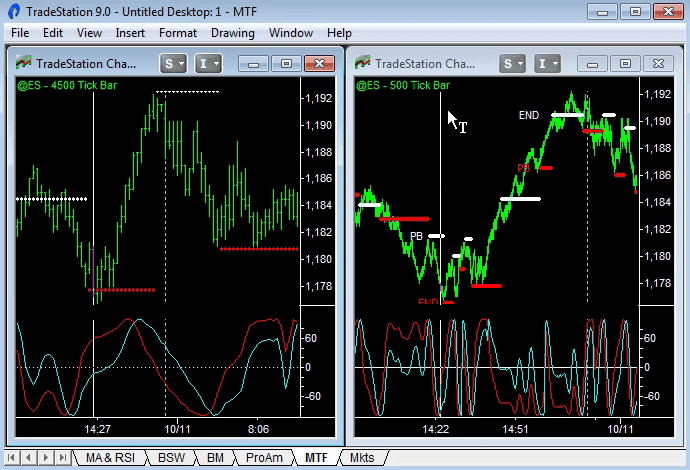
Then when these patterns using the Hilbert Sine Wave (along with volume momentum and average trade size indicators) occur simultaneously in two different time frames, the probability of a valid market turning point is greatly increased!
Trend moves in lower time frames will look like large cycle moves in higher time frames, as shown in the Emini 4,500 and 500 tick charts above. In the highest time frame (4,500 tick) we have a cyclical move up from 1,178 to 1,192 highlighted. In the lowest time frame (500 tick) the market has made a Pull Back to End of Trend sequence at the lows around 1,178 and then proceeds to make a mirror Pull Back to End of Trend sequence at the highs around 1,192.
The cyclical turns in the highest time frame is used to determine the overall trend. Then the lowest time frame is used to time entries. In my trading I use 3 time frames, each a multiple of 3 times the lower time frame:
- Day Trading: 500, 1,500 and 4,500 tick (500 x 3 = 1,500 and 1,500 x 3 = 4,500)
- Swing Trading: 45 min, 135 min and Daily (45 x 3 = 135 and 135 x 3 = Daily)
- Position Trading: Day, Week and Month (Day x 5 = Week and Week x 4 = Month)
- Or anything in between: 1 min, 3 min, 9 min or 5 min, 15 min, 45 min, etc.
When turning points in 2 of the 3 time frames coincide, the chances of a large range move are increased. Since the Better Sine Wave indicator can be used to predict cyclical turning points AND the end of trending periods, it is uniquely capable of being used in multiple time frame analysis.
Again, remember to look for confirmation from volume momentum and average trade size patterns to increase your winning percentage.

The beauty of the Better Sine Wave indicator, and the support and resistance levels it generates, is that it can be used to define market structure in any time frame:
- Tick bars
- Minutes
- Hourly
- Daily
- Weekly, and
- Monthly
And for any instrument or market:
- Futures
- Stocks
- FX
- Indices
- Options, etc.
- The Better Sine Wave is a unique indicator – it combines the best characteristics of an oscillator as well as the best characteristics of a moving average.
- The “Better Sine Wave” is an improved version of John Ehler’s Hilbert Sine Wave – it defines market structure with support and resistance levels during cyclical periods; and breakouts, pullbacks and end of trend signals during trending periods.
- Market turning points and high probability trades can be identified using the Hilbert Sine Wave in combination with volume momentum and average trade size analysis.
- Trend moves in a lower time frame are cycle moves in a higher time frame – a key concept when trading with multiple time frames. Again, this can be used to confirm turning points and identify high probability trades.
- The “Better Sine Wave” indicator works in any time frame (tick to monthly charts) and for any market (futures, stocks, forex, etc.).

